
Augustin Barruel was a French journalist, intellectual, and Jesuit priest. He is now mostly known for setting forth the conspiracy theory involving the Bavarian Illuminati and the Jacobins in his book Memoirs Illustrating the History of Jacobinism published in 1797. In short, Barruel wrote that the French Revolution was planned and executed by the secret societies.

Étienne Charles de Loménie de Brienne was a French clergyman, bishop, cardinal, politician and finance minister of Louis XVI.
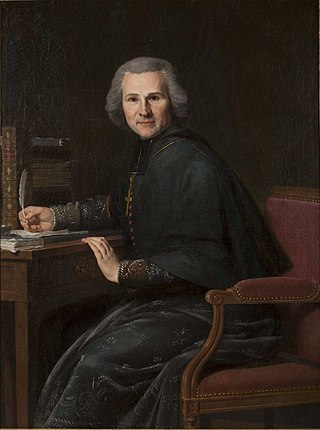
Henri Jean-Baptiste Grégoire, often referred to as the Abbé Grégoire, was a French Catholic priest, constitutional bishop of Blois and a revolutionary leader. He was an ardent slavery abolitionist and supporter of universal suffrage. He was a founding member of the Bureau des longitudes, the Institut de France, and the Conservatoire national des arts et métiers.
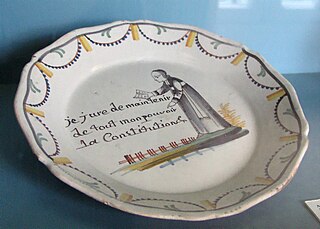
The Civil Constitution of the Clergy was a law passed on 12 July 1790 during the French Revolution, that sought the complete control over the Catholic Church in France by the French government. As a result, a schism was created, resulting in an illegal and underground French Catholic Church loyal to the Papacy, and a "constitutional church" that was subservient to the State. The schism was not fully resolved until 1801. King Louis XVI ultimately granted Royal Assent to the measure after originally opposing it, but later expressed regret for having done so.

Jean-Baptiste-Joseph Gobel was a French Catholic cleric and politician of the Revolution. He was executed during the Reign of Terror.
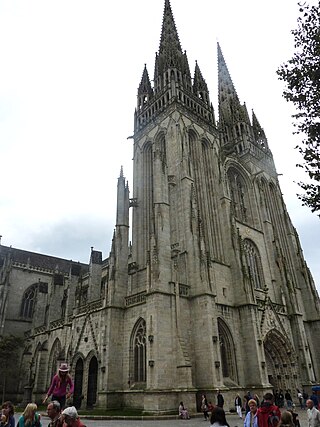
The Diocese of Quimper (–Cornouaille) and Léon is a Latin Church ecclesiastical territory or diocese of the Catholic Church in France. In 1853, the name was changed from the Diocese of Quimper (–Cornouaille) to the Diocese of Quimper (–Cornouaille) and Léon.

The Diocese of Autun (–Chalon-sur-Saône–Mâcon–Cluny), more simply known as the Diocese of Autun, is a Latin Church diocese of the Catholic Church in France. The diocese comprises the entire Department of Saone et Loire, in the Region of Bourgogne.
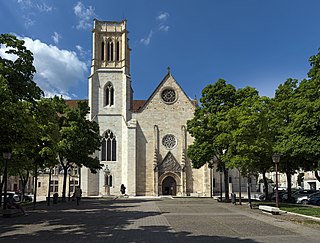
The Diocese of Agen is a Latin Church ecclesiastical territory or diocese of the Catholic Church in France.

The Diocese of Saint-Flour is a Latin diocese of the Catholic Church in France. The diocese comprises the department of Cantal. Erected in 1317, the diocese was suffragan of the Archdiocese of Bourges until 2002. With the general reorganization of the structure of the French church by Pope John Paul II, Saint-Flour became the suffragan of the Archdiocese of Clermont. The seat of the bishop is located in Saint-Flour, Cantal.

Jean-Baptiste Count de Belloy was an Archbishop of Paris and cardinal of the Catholic Church.

The Diocese of Nancy and Toul is a Latin Church ecclesiastical territory or diocese of the Catholic Church in France. After a considerable political struggle between Louis XV, Louis XVI, and the Dukes of Lorraine, the diocese was erected by Pope Pius VI on 17 December 1777. The Diocese of Nancy is a suffragan diocese in the ecclesiastical province of the metropolitan Archdiocese of Besançon.
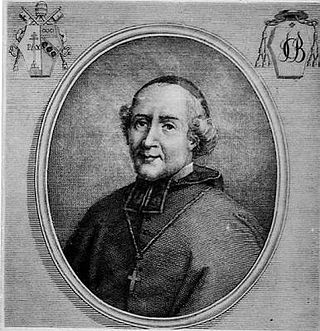
Jean de Dieu-Raymond de Cucé de Boisgelin was a French prelate, statesman and cardinal. The Boisgelin of Cucé are the Cadet branch of the maison de Boisgelin). His cousin is the famous author Louis de Boisgelin.

The Diocese of Moulins is a Latin diocese of the Catholic Church in France. The episcopal see is located in the city of Moulins. The diocese comprises all of the department of Allier in the region of Auvergne.

The Diocese of Blois is a Latin Church diocese of the Catholic Church in France. The diocese lies in western France, and encompasses the department of Loir-et-Cher. Since 2002 it has been a suffragan of the Archdiocese of Tours.

The Archdiocese of Dijon is a Latin diocese of the Catholic Church in France. The archepiscopal see is Dijon Cathedral, which is located in the city of Dijon. The diocese comprises the entire department of Côte-d'Or, in the Region of Bourgogne. Originally established as the Diocese of Dijon in 1731, and suffragan to the Archdiocese of Lyon, the diocese was elevated to the rank of archdiocese in 2002. The most significant jurisdiction change occurred after the Concordat of 1801, when the diocese annexed the department of Haute-Marne. In 1821, a papal bull re-established the Diocese of Langres. Since 2022 the archbishop has been Antoine Hérouard.
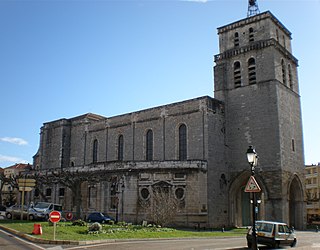
The former French Catholic diocese of Alais was created in 1694, out of territory previously part of the diocese of Nîmes. It was suppressed after the French Revolution, with its territory being divided between the diocese of Avignon and the diocese of Mende. Its seat was Alès Cathedral.
Pierre Brugière was a French priest and Jansenist, who supported the French Revolution and the reforms it sought to bring to bear on the Catholic Church.

Antoine-Adrien Lamourette was a French priest and politician. During the French Revolution he accepted the Civil Constitution of the Clergy and became the first constitutional bishop, in schism from the Roman Catholic Church, becoming bishop of Rhône-et-Loire (Lyon).

Pierre-Louis Leysin was a French clergyman who was the 81st and last Archbishop of Embrun from 1767 to 1790. Having refused to take the constitutional oath, he died in exile.
The term "Red Priests" or "Philosopher Priests" is a modern historiographical term that refers to Catholic priests who, to varying degrees, supported the French Revolution (1789-1799). The term "Red Priests" was coined in 1901 by Gilbert Brégail and later adopted by Edmond Campagnac. However, it is anachronistic because the color red, associated with socialist movements since 1848, did not signify supporters of the French Revolution, who were referred to as "Blues" during the civil wars of 1793–1799, in contrast to the royalist "Whites." Hence, a recent historian suggested using the term "Philosopher Priests" to describe this group, a term used at the time to refer to these priests.

















